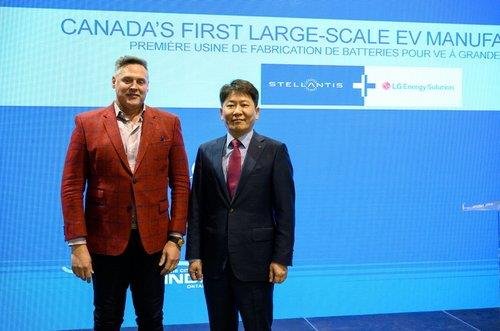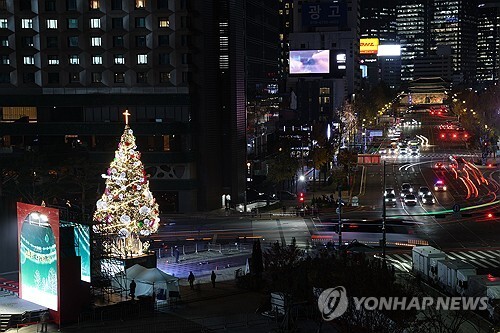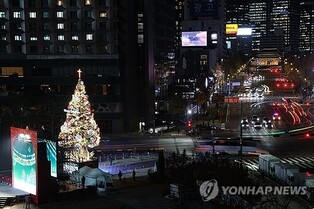 |
| ▲ Stellantis Chief Operating Officer Mark Stewart (L) and the head of LG Energy Solution's advanced automotive battery division, Kim Dong-myung, pose for a photo at the ceremony announcing their joint venture to build an electric vehicle battery plant in Ontario, Canada, on March 23, 2022, in this file photo provided by LGES. (PHOTO NOT FOR SALE) (Yonhap) |
(LEAD) LG Energy Solution-Ontario plant
(LEAD) LGES, Stellantis resume Ontario plant construction as subsidy deal reached
(ATTN: RECASTS headline; REWRITES 3rd para to add more context; ADDS more info in para 9)
By Kim Seung-yeon
SEOUL, July 6 (Yonhap) -- LG Energy Solution Ltd. (LGES) said Thursday its joint venture with Stellantis N.V. has reached an agreement with the Canadian governments on the terms of subsidies for the construction of its electric vehicle (EV) battery plant in Ontario.
The binding agreement puts the construction of the battery module manufacturing facility in Windsor immediately back on track, the companies said.
The deal came about two months after they suspended part of the project over a delay by the Canadian federal and local governments in setting the conditions for incentives as promised to be on par with the U.S. Inflation Reduction Act (IRA), which provides tax credits of up to US$7,500 to buyers of EVs assembled only in North America.
"We are pleased that the federal government, with the support of the provincial government, came back and met their commitment of leveling the playing field with the IRA. This collective effort enabled the deal to close, and we are now resuming construction on the site in Windsor," Mark Stewart, Stellantis' chief operating officer for North America, said in a release.
"We are happy to finally move forward with building the country's first major battery plant and be a central part of the local battery ecosystem," said Kim Dong-myung, president and head of LGES' advanced automotive battery division.
In May, LGES and Stellantis said they had halted the construction of the battery module factory amid apparent haggling between the Canadian federal and provincial governments over who should pay more incentives.
While the battery cell plant was still under construction, the decision put the brakes on what will be a more than 4.8 trillion-won (US$3.6 billion) joint venture between the world's second-largest battery producer and No. 4 automaker.
LGES and Stellantis launched their joint venture, NextStar Energy, in March last year to build an EV battery manufacturing plant with an annual production capacity of 45 gigawatt hours.
The Ontario plant aims to be completed in the first half of 2024.
If the Ontario plant reaches its maximum production targets, NextStar Energy could receive as much as C$19 billion (US$14.3 billion) in financial support from the Canadian governments over the next decade, the local outlet Windsor Star has reported, citing an estimate from an unidentified source.
The output from the Ontario plant will be supplied to Stellantis assembly plants in the area, which manufacture its famous brands, such as Chrysler and Jeep SUVs.
(END)
(C) Yonhap News Agency. All Rights Reserved
























![[가요소식] 지코, 요아소비 이쿠라와 신곡](/news/data/20251212/yna1065624915953509_920_h2.jpg)










